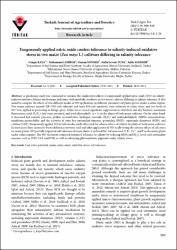Exogenously applied nitric oxide confers tolerance to salinity-induced oxidative stress in two maize (Zea mays L.) cultivars differing in salinity tolerance
Abstract
A glasshouse study was conducted to examine the ameliorative effects of exogenously applied nitric oxide (NO) on salinity-induced oxidative defense mechanisms and some vital metabolic attributes in two maize cultivars differing in salinity tolerance. It also aimed to compare the effects of two different modes of NO application on different parameters of plants grown under a saline regime. Two maize cultivars, namely DK 5783 (salt-tolerant) and Apex 836 (salt-sensitive), were subjected to saline stress, and two levels of NO were applied as presowing or foliage spray. Saline stress caused significant suppression in total fresh and dry biomass, maximum fluorescence yield (F-v/F-m), leaf water potential, and total chlorophylls (a + b) in the plants of both maize cultivars. On the other hand, it increased leaf osmotic pressure, proline accumulation, hydrogen peroxide (H2O2) and malondialdehyde (MDA) concentrations, membrane permeability, and the activities of some key antioxidant enzymes, peroxidase (POD), superoxide dismutase (SOD), and catalase (CAT). Exogenously applied NO in both modes partly alleviated the adverse effects of salinity on plants of both maize cultivars. In most cases there seemed to be no difference between seed and foliar application of NO in alleviating the adverse effects of salt stress on maize plants. NO partially improved salt tolerance of maize plants; it reduced Na+ but increased N, K+, Ca2+, and P in the maize plants under saline regimes. The NO treatment conferred enhanced tolerance to salinity by reducing MDA and H2O2 levels and antioxidant enzymes such as SOD, CAT, and POD, as well as enhancing photosynthetic pigments under salinity stress.


















